Table of Contents
Ghost Shrimp: A Quick Summary
Ghost shrimp, also known as glass shrimp, are small, transparent crustaceans commonly found in freshwater aquariums. They are popular among hobbyists for their ability to help clean tanks and their peaceful nature. Ghost shrimp are not ideal for large tanks due to their small size and fragility, but they can make great additions to smaller aquariums.
Ghost Shrimp Overview
The ghost shrimp, or glass shrimp as it is otherwise known, is a very inexpensive and easy to keep crustacean. It can be kept as a feeder for larger and more aggressive fish, such as cichlids for example, which would hunt shrimp all day long.
Ghost shrimp are great aquarium cleaners, as they are scavengers and search the gravel for food or leftovers from other tank inhabitants. This is why the tank they are kept in should not be the cleanest.
Although they are very small creatures, be careful not to overcrowd smaller tanks with fish and shrimp. Ghost shrimp will also contribute to the tank’s bioload, which will decrease the water quality and cause an unhealthy environment.
Due to their translucency, ghost shrimp look good in aquariums with black substrate/background or many live green plants.
However, when we are talking about Ghost Shrimp, there are a few popular varieties of it. In this care guide, we’ll focus primarily on the freshwater Ghost Shrimp and how it can be an ideal addition to your home tank.
| Information Chart | Ghost Shrimp |
| Scientific Name | Palaemonetes paludosus |
| Family | Palaemonetes |
| Care level | Easy |
| Temperament | Peaceful |
| Color | Transparent and clear |
| Lifespan | Up to 1 year |
| Size | 1.5 inches |
| Diet | Omnivores |
| Minimum size tank | 5-10 gallons |
| Temperature | 65 degrees and 82 degrees Fahrenheit |
| Water conditions | Tropical freshwater |
| Tank mate compatibility | Peaceful, small fishes, shrimp species |
Ghost Shrimp Appearance
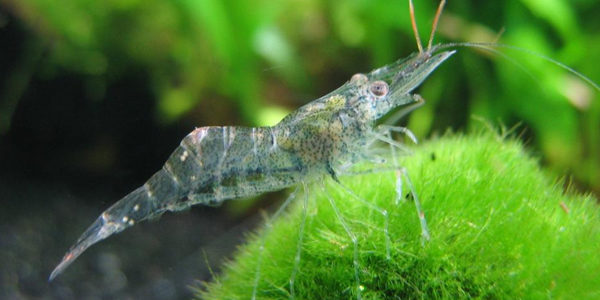
Like the name of this invertebrate suggests, ghost shrimps are clear or transparent in color. The primary reason behind this is to evade the chase of predators who live in the natural habitats and the home tanks.
However, these shrimps’ clear appearance also contributes to a fascinating view of how their body works and how they process food. If you are an aquarist interested in learning more about the morphology and physiology of aquatic life, these shrimps are hands down the best way to start.
Besides their transparent body, the ghost shrimp anatomy includes two antennas fitted to the top of their head – both of varying sizes. However, their antenna has significant sensory functions and helps detect chemical changes in the water body and even food.
Another unique sight in their appearance is the rostrum, a beak-like extension situated just between the eyes and the shrimp’s carapace. The primary function of the carapace is to provide a protective outer covering to the shrimp while they are swimming around.
Just behind the carapace is where you will find the infamous swimming limps, otherwise known as pleopods, that connect directly to the tail. They also have a tail fan embodying the exterior of the uropod, giving them their characteristic look and appearance.
Lifespan of Ghost Shrimp
The typical lifespan of a ghost shrimp is between 8 months to a year. However, this isn’t a standard time frame because some of them can live less or more, depending on the environments they are kept in and their feeding in the tank.
Besides being kept as a part of the tank, some aquarists even add a bunch of ghost shrimp as feeder fish for the other larger fish. In such cases, their care isn’t the aquarist’s priority, and they are thus kept in poor living conditions, leading to premature death in the tank.
Another part of their lifecycle worth mentioning is the regular molting process that they undergo. The molting frequency depends on the quantity of food the shrimps are eating and how quickly they switch from their standard size. Generally, they molt when they become larger than their shell.
Ghost Shrimp Size
The typical size of a mature ghost shrimp is not more than 1.5 inches. The male ones are comparatively shorter than the adult female shrimps.
However, despite their length, they aren’t very wide in appearance, which is why they appear sleek and thinner than some of the other shrimp species, especially the peppermint shrimp. These shrimps’ smaller and intangible size is also why they are often offered as a live feed to the larger fish species.
Natural Habitat and Origin
Ghost shrimps are popular freshwater crustaceans that are found in several lakes in North America. Although aquarists know that they hail from freshwater regions, their origin is not that clear. However, they were first officially classified in the early 1800s, which is a few centuries ago.
Although they were fascinating to look at during the initial days of their discovery, their existence became very common as the days passed. They are rarely kept as an addition to the community tanks and are mostly used as a live feed.
If you are wondering about their nature, ghost shrimps are timid about their surroundings. However, they are an active species and are often categorized as aquarium cleaners because of the algae they feed on. So, they are a significant part of aquaculture.
Ghost Shrimp Care and Tank Set-up
Contrary to what many think, ghost shrimps are extremely vulnerable in their natural habitat, especially in the rivers and lakes containing many larger fish species. So, when setting up a tank for them, mimicking a similar backdrop and set-up is crucial to adapt to the surroundings easily.
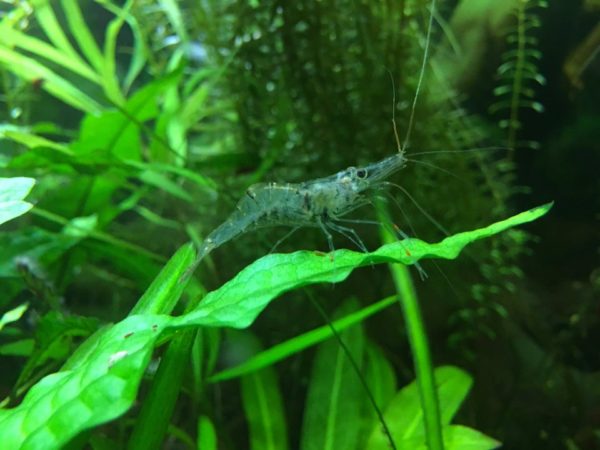
Given the small size of these shrimps, you will often find that they fit right in the smaller tanks and with the bare minimum in them. For your convenience as a beginner, we will discuss everything related to the tank setup that you need to know about.
Ghost Shrimp Tank Size and Specifications
It doesn’t matter whether you keep the ghost shrimp alone or in groups, make sure that you fill the tank with enough crevices and hiding spots so the ghost shrimps don’t feel in danger all the time. This is one of the leading causes of stress and premature death in these small crustaceans.
Following are some of the crucial details about tank set-up that you need to be mindful of:
Optimum tank size for Ghost Shrimp
The minimum tank size recommendation for ghost shrimp is 5 gallons. You can house 3-4 shrimps per gallon of water, which means that a 5-gallon variant can easily house 10-15 of these small invertebrates in them.
However, if you are keeping them in a community tank, you need to be extra careful of the other fish species that you pair them with.
Filter Type
When it comes to water filtration, you need to integrate a light flow filter that won’t generate heavy water current.
A water filter should always be available in the aquarium, even though ghost shrimp like to do all the cleaning. An internal sponge filter is the best option, especially if you have a small tank (about 5-gallons), as it will also provide an extra food source.
For large tanks, external filters are a better option, as they help change foul water and larger debris.
Substrate
Ghost shrimp, like many other shrimp species kept in the home tanks, are bottom feeders. So, you will often find them navigating down to the bottom of the tank in search of food or a hiding spot from their predators.
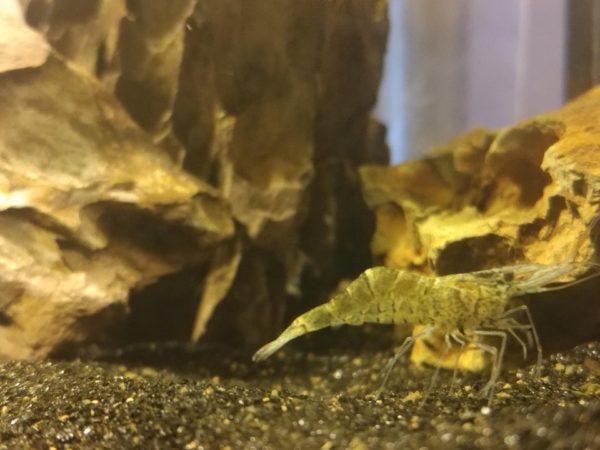
So, make sure that you fill the bottom with the fine but dark-colored substrate so you can spot the transparent colored ghost shrimps in the tank. Fine sand works the best as a substrate for the tank since these shrimps have a habit of digging into the substrate for food. Any kind of rough-edged substrate will end up causing injuries or even make it harder for them to find food to eat.
Water Parameters for Ghost Shrimp
Ghost shrimps babies and adults are very adaptable to the water conditions you place them in. This is why you don’t have to go overboard with the water parameters and maintain the favorable conditions to their lifestyle.
When setting up the tank for ghost shrimps, you need to be mindful of three things: temperature, pH, and water hardness.
Water temperature
The ideal water temperature for ghost shrimp is between 65 degrees and 82 degrees Fahrenheit. This means that these small invertebrates prefer living in warm water conditions, so you need to pair them with fish species that favor warm water.
Higher temperatures can accelerate growth and reproduction rates, while lower temperatures lower the shrimp’s immunity and disease.
A heater should be placed in the aquarium if kept in a colder room or if you live in a colder climate.
pH level
The perfect water pH level for ghost shrimp is between 7.0 to 8.0, which indicates that they prefer neutral to slightly alkaline water conditions, which is very easy to recreate in the home aquariums.
Be very careful when treating water or other fish in the aquarium with medication. Ammonia, nitrites, and nitrates should always be monitored and, most of all, avoid copper accumulating in the water, as it is fatal to the shrimp.
Nitrites and ammonia should be 0, while nitrates should never be higher than 20ppm.
Water Hardness
The only standout factor with the water parameters is the water hardness because they rely on soft water conditions with a scale between 3.72 and 6.75.
Ghost Shrimp Tank Landscape
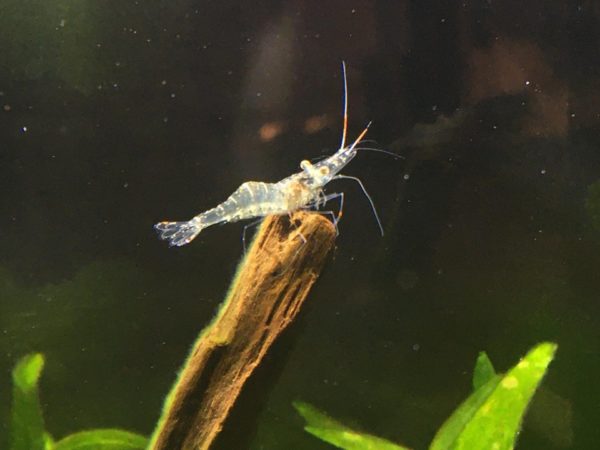
Ghost shrimp like to live with many live plants in an environment of moderately moving water. They can even tell a live plant from a fake one; live aquarium plants provide shed-matter shrimp like to eat, leading to a cleaner aquarium.
Also, plants, along with decorations and rocks, provide ideal hiding places for the little crustaceans and make them feel more at home.
When you generally go to buy ghost shrimps for your home aquarium, you will often notice some of them chucked into a plain transparent tank with no hideouts or decorations. Those are the live feeds. If you want to house a ghost shrimp, that is the last thing you want to do.
Setting up the inside of the tank for a ghost shrimp does require some important pointers and reminders that we will discuss now.
Best Plants for Ghost Shrimp Tank
As we mentioned before, fine sand and gravel make the best substrate for the ghost shrimp tank. These are easy to dig through and don’t inflict any kind of pain or injury to the shrimp while they are down at the bottom looking for food.
However, simply relying on the substrate will only get you so far. Instead, you need to fill up the tank with different aquatic live plants to replicate their natural living conditions in the lakes and rivers.
Plants like java moss and hornwort make up for the two best options for live plants. Utricularia Graminifolia is also good for them. Besides being a good spot for hiding, keeping live plants in the tank also generates algae that the shrimps feed on now and then.
Lighting for Ghost Shrimp Tank
Besides the live plants, an aquarist also needs to be mindful of the lighting conditions in the tank. If you are extremely critical about the lighting, let us ease your mind by saying that the ghost shrimps don’t necessarily care about it.
They are bottom dwellers and bottom feeders, so they won’t have a specific day or night cycle for active or hiding out. So, if you want, a plain LED aquarium light on the top will get the job done just fine.
Feeding Ghost Shrimp
It’s very easy to feed your ghost shrimp, as it will eat almost anything found in the aquarium. Their diet consists of algae, dead plant matter, or uneaten bits of food. Also, boiled soft vegetables can be an inexpensive solution while providing the shrimp with many nutrients.
Of course, processed foods can also be fed to the ghost shrimp, such as pellets designed for small fish or shrimp, fish flakes, or wafers. Mostly anything that can easily be broken into small bits will be acceptable.
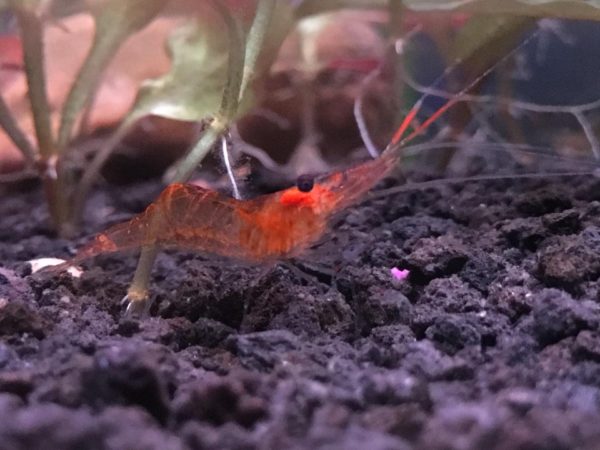
As the ghost shrimp has clear bodies, food can be seen while passing through the digestive system. Ghost shrimp should be fed twice a day and given the amount of food eaten in about 1-3 minutes.
Their broad spectrum of eating habits makes them perfect aquarium cleaners because they will gobble down the food from the bottom, clear out algae deposition and ensure that the tank doesn’t have unnecessary food remnants in it. They also feed off of plant debris in case a plant has died in the tank.
What kind of food you feed your ghost shrimp depends on the height of the tank. If the tank is too tall, the chances of these shrimps coming up to the surface to feed off the flakes is very low. In such cases, you can rely on sinking pellets to feed them.
A few other feeding factors worth considering is that these small ghost shrimps need a good calcium supplement now and then. Since they molt quite frequently, the calcium helps build a stronger shell. Also, try to avoid any kinds of food sources containing copper because that is highly toxic and fatal for the shrimps.
Ghost Shrimp Behavior and Temperament
Ghost shrimps, like the other shrimp species, are very peaceful and like to keep to themselves. You will find them spending the majority of their day on the bottom of the tank, either digging for food or hiding from the predators.
During and after their molting, you will find these shrimps hiding away in the crevices and caves to protect them from the predators in the tank. They will do so until their shell reforms and hardens on the exterior.
Besides their general nature, they aren’t very societal in larger community tanks with different fish species and like to keep to themselves most of the time. You will find them swimming around in the tank now and then, but it is very easy to lose them out of sight due to their clear body.
Ghost Shrimp Tank Mates
Ghost shrimp do best in a one-species aquarium or other small shrimp species, like the Red Cherry or the Crystal Red Shrimp. They are pretty social creatures and interact well with their kind.
If you plan to keep your ghost shrimp on their own, keep in mind that too many can get aggressive against each other.
Ghost shrimp can be placed with other small snails or fish, such as the Betta Splendens, but it always depends on the Betta, as their moods are prone to sudden changes. Some aquarists observed Bettas would constantly chase the shrimp or start hunting it suddenly after a long while it didn’t care about it.
The best option when placing shrimp and fish together is to start with a well-established shrimp population, as safety in numbers will decrease the chance of ghost shrimp being eaten.
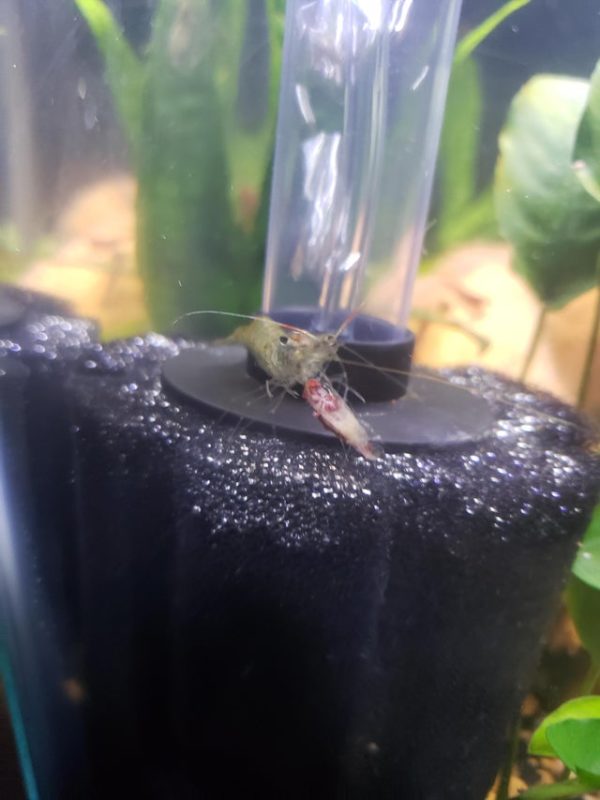
Keep in mind that larger fish are very likely to eat or harass the shrimp, so consider placing it only with smaller fish. Young glass shrimp should only be kept with other shrimp, as they are even more vulnerable than the adults.
Breeding Ghost Shrimp
If you are housing ghost shrimps with an intent to breed them, you won’t have to go out of your way to do anything in excess. Just ensure that they are kept in a tank with the same species and with no predators in sight.
When there are no predators and no external stress, it becomes easier and natural for these shrimps to breed.
However, if you have the ghost shrimps stationed in the community tank and you want to breed them, setting up a breeding tank is important.
Transfer the female and male ghost shrimp into the breeding tank and wait for them to produce eggs around their leg region. They can produce 20-30 at a time. The male ones then approach the female shrimps and fertilize the eggs.
Make sure you keep a close eye during that process and remove the male ghost shrimps once the fertilization is done. The pregnant ghost shrimp will stay alone in the breeding tank until the eggs hatch.
Once the eggs hatch successfully, transfer the female ghost shrimp into the community tank because they don’t show maternal instincts and can eat their fry. Ensure that you fit a good-quality sponge filter into the breeder tank to keep a steady water flow without the small shrimps getting sucked into the machine by mistake.
Since the newly hatched shrimps have a very tiny body and mouth, you want to feed them the littlest amount of food and supplement to nurture them and help them grow to become stronger and mature. Once they have grown into full-sized adults, you can feed them the standard foods that you would with a larger adult ghost shrimp.
Ghost Shrimp Common Diseases and Treatment
Like any other invertebrate in the tank, even ghost shrimps are susceptible to a few water-borne diseases that aquarists should be aware of.
One of the most common diseases that affect the ghost shrimp is Vorticella. The disease comes from algae that the shrimps feed on, making their body and the clear shell look white and moldy in nature and texture.
Besides Vorticella, a bacterial infection is another common issue that most ghost shrimps suffer from. If you find the shrimp extremely fatigued or showcasing bright pink spots on the shell with swelling, it is a sign of bacterial infection caused by poor water conditions.
The best way to treat both diseases is to have a clean tank with reduced levels and ammonia and nitrate in them. If you aren’t cleaning the tank or treating it with salt every week or every two weeks, these diseases will affect the shrimps and other inhabitants in the tank.
If the ghost shrimp is infected with a bacterial infection, you need to immediately separate it from the main tank to prevent the others from getting an infection. 9/10 times, the bacterial infection leads to the premature death of the shrimp.
Are Ghost Shrimp Right for You?
From the small size to the ease of care, ghost shrimps are ideal for beginners who want to introduce invertebrates into their tanks. They are extremely cheap, which means that you can buy a bunch without paying a hefty amount like with other fish species.
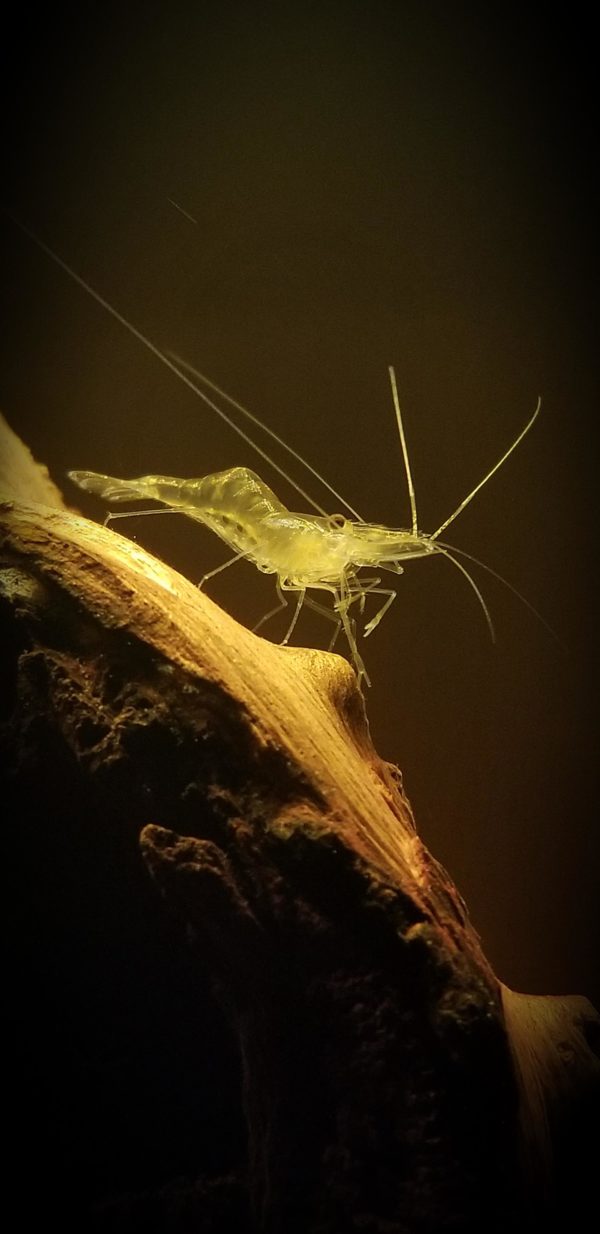
All you have to do is put in a little effort to take care of them and be fascinated by their beautiful nature and appearance. Besides the unique appearance, these small shrimps are quite active when they want to, which again keeps the aquarists amused from time to time.
FAQs
Do ghost shrimps molt?
Yes, ghost shrimps molt every few days, especially when they have eaten a lot more than they generally would. If their body becomes larger and can’t fit into the shell anymore, they molt and shed the shell. During that time, they undergo regeneration and hideaway in the crevices in the tank.
Do ghost shrimp eat fish poop?
Ghost shrimps do nibble on fish poop now and then. However, they don’t necessarily feed on the poop altogether and will just inspect and nibble on it.
Why do my ghost shrimp keep dying?
One of the most common reasons behind premature death is due to poor water and living conditions. Also, if the shrimp is paired with other larger fish species that they feel threatened to, it can put them under stress and result in death.
Do ghost shrimp clean tanks?
To an extent, ghost shrimps clean up tanks by eating algae, plant debris, and other food remnants in the bottom. However, don’t expect to rely on them solely for cleaning the tank. You need to do it manually as well.
Do ghost shrimp eat moss balls?
While the ghost shrimps don’t eat moss balls, the addition to the tank helps the shrimp graze on it and hide away in their crevices. Only the amono shrimp have a habit of nibbling and tearing apart the moss balls in the tank.
Should I remove death ghost shrimp?
If the ghost shrimp have died of natural causes, you don’t have to worry about removing them because larger fishes will eat them. However, if they died due to an illness, especially a bacterial infection, you must remove them immediately without any questions.
Do ghost shrimps jump out of tank?
Ghost shrimps are bottom dwellers, so you won’t find them swimming up to the surface of the tank. This means there are little to no risks of them jumping out of the tank.
Can ghost shrimp live with bettas?
Yes, ghost shrimps and bettas can live together. However, we’d recommend that you put enough hiding spots in the tank so the shrimps can protect themselves instead of becoming a feast. Read more on this in detail on our guide ghost shrimp compatibility with bettas.
Conclusion
Ghost shrimp are pretty little creatures and inexpensive in bulk quantities, and very easy to keep. They make an interesting addition to small aquariums or can form a colony of their own.
Glass shrimp are also useful in reducing nitrates and algae while having a very low biological footprint, but you should always watch a tank containing fish and shrimp together. With a little monitoring of the tank, they can live up to two years.
If all these sound appealing to you and you don’t want the extra hassle of taking care of complex fish species, ghost shrimp babies are the perfect addition to your tanks. We hope this guide gives you all the inputs you need to know if there is anything else you need information on, leave us a question in the comments.
No related posts.
